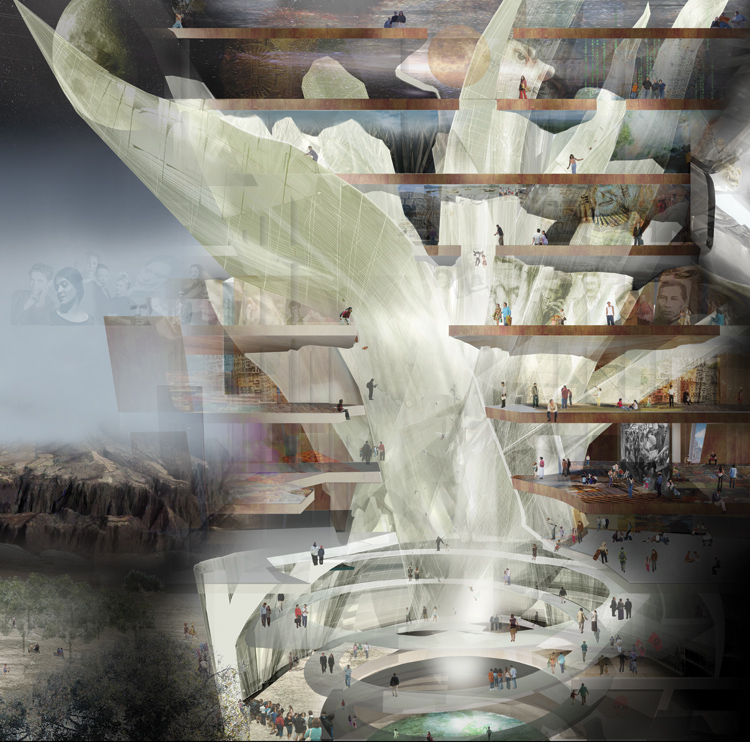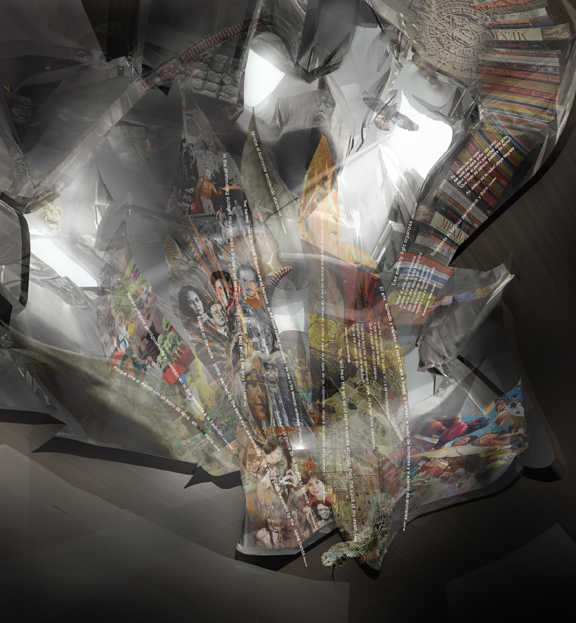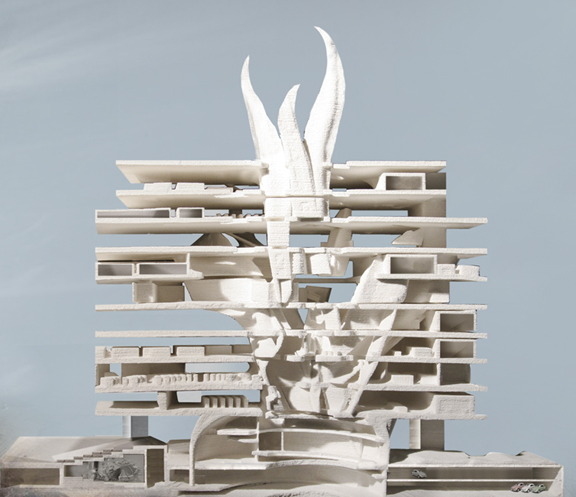

| La Nueva Biblioteca Publica del Estado de JaliscoGuadalajara, MexicoWithin the shadows of La Barranca de Oblates, La Nueva Biblioteca Publica del Estado de Jalisco emerges from a limestone plaza, Ixtli Caliza, lined with Zapote trees. A safe box " caja de tesoros " for books and media sheathed in a copper manta de luz (jacket of light), La Biblioteca envelopes an abstract glass maguey, un fuego detenido (frozen fire) from the past, again awakened. This arbol de maravillas "tree of wonders, as it is known to the Otoni people" is a source of agua miel (sweet water) and symbol of the culture, landscape and people of Mexico. For the Nahuatl, the maguey was a divine creation representing the goddess Mayahuel. Like Juan Diego's manta enclosing divine roses, or silent walls sheltering a verdant private garden, the copper caja environmentally and spiritually protects La Biblioteca, selectively revealing layers of life, culture, and activity within. A collector of cultures, mixing pueblo and university, casual user and academic, La Biblioteca and its plaza fill with fiesta, quinceneras and tiangis, children and jubilados, business people, and tourists. Displacements of program elements below "Theater, Auditorium and Classrooms" surface on the Plaza creating a topography for shaded casual gatherings. From origins within the earth, La Biblioteca grows from a cenote" mythic well touching ancient subterranean waters of Lake Chapala" mirror-like, a reflection of the Azteca calendar stone. A limestone palenque (amphitheater) embraces the Cenote. La Pina "heart of the abstract maguey, of La Biblioteca and the village of Zapopan" rises through the plaza as a crystalline volume housing the main Library entrances, Mercado, Cafe, after-hours book return and sorting, Information Desk, Orientation Theater and Gallery, providing centrality of movement and introduction to the glazed pencas (leaves of the maguey). Viscous obsidian ramps "like obsidian deposits found at Cerro Collí " spiral up through the Pina, inviting visitors through the Gallery and the Orientation Theater up to the Biblioteca collections. From the central open core of the glass maguey, the pencas reach toward the sky, the sun, views of city and land beyond, toward Ixtepete, El Grillo, Cerro el Cuatro and Cerro Collí. The pencas are a deep timeline reflection of Mexican exuberance/ fiesta/ pachanga from Aztec cosmology to the future, from mestizaje to indigena, charting a kaleidoscope of time. Each penca "a magical, fluid realm of memory and pueblo as in the writings of authors such as Juan Rulfo and Elena Garro" emanates from the Pina to carve through la Biblioteca. A repository of memory and conveyor of the intellectual and spiritual flow of La Biblioteca, the pencas reach from the Cenote to the roof-top Cyber Garden, El Jardín Xallí, as sinuous conductors of diffuse light, illuminating and organizing the collections, disseminating embedded digital technology and information, and orienting users. Pencas that escape through the roof-top garden, project beams of light into the night, becoming a beacon for Jalisco. Other pencas imprint the exterior walls of the Biblioteca, deflecting the copper skin. Ventilating cavities along the perimeter also create the manta de luz condition, where light is captured and selectively released to the interior. Counterpoint to the exuberant glass maguey, rows of regular, precisely ordered stacks are a datum of clear organization, facilitating staff movement and overview while encouraging immersion in study or social interaction. Although the book as object is finite, a Borgesian infinity of textual intensity emerges through each touch and thought. Through journey / procession / pilgrimage, the visitor engages the library toward individual ends, seeking that which inspires and illuminates. La Biblioteca visually culminates in el alto grito como la flor amarilla del maguey a la hora de su muerte. Una serenata a la luna.
|
|
||||||||||||||||
|
|

